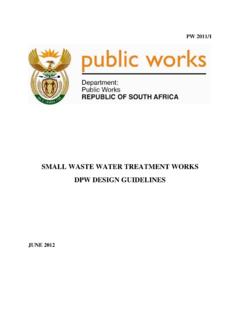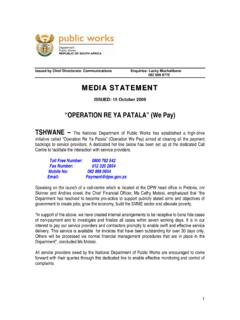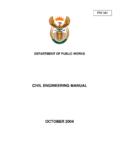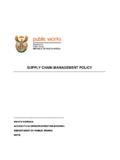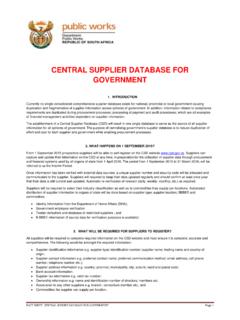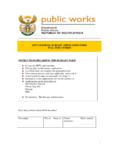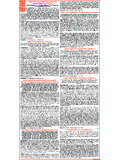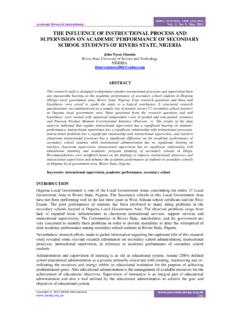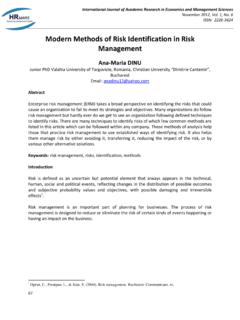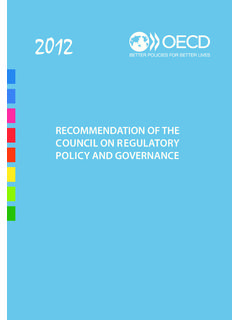Transcription of Department of Public Works Strategic Plan 2012-2016
1 Department OF Public Works | Strategic plan | 2012 -2016 Department of Public WorksStrategic Plan2012-2016I have the honour of submitting the Strategic plan for 2012 -2016 of the Department of Public Waltermade Nxesi, MPMINISTER Department OF Public WORKSS trategic 12012/03/15 11:25 AMDEPARTMENT OF Public Works | Strategic plan | 2012 -2016 Strategic 12012/03/15 11:25 AMDEPARTMENT OF Public Works | Strategic plan | 2012 -2016iiiMinister s ForewordIn preparing this five year Strategic plan which sets out key policy priorities to deliver on our mandate, the Department of Public Works has had to reflect on a number of significant challenges that have affected the Department s ability to fulfill its mandate through improved infrastructure expenditure for better service delivery. We have also had to reflect on the consequences of the Department s negative audit outcomes in the past five years and a decline in Public confidence in our ability to account for Public funds in executing our mandate.
2 This Strategic plan is therefore a culmination of these reflections in the context of a decision to implement a turnaround strategy in the forthcoming planning period. Against the backdrop of poor performance and negative outcomes received from the Auditor-General and the Special Investigations Unit, key areas for prioritization have been identified by the Department for the planning period 2012 /13 2016/17. These hard decisions have to lend themselves well to the ten national policy priorities adopted by Government in 2009. As a country, we are faced with a reality that acknowledges successfully the improved access to services and an increased expenditure on service delivery. But we also acknowledge that development indicators reveal that significant levels of poverty, unemployment and inequality still persist unevenly across the geography of South Africa.
3 This is articulated well by the President of the Republic of South Africa in his 2012 State of the Nation Address (SONA) and the role of infrastructural development in revitalising our economy therefore takes precedence. The Department of Public Works ; as a leader in the provision of government building infrastructure in South Africa; plays a critical role in providing an enabling environment for the effective and efficient provision of infrastructure. The Strategic plan for the years 2012 /13 2016/17 is therefore informed by such national priorities drawn from the Medium Term Strategic Framework reflections that make it obligatory for us as a Department that is the biggest single player in the construction and property sectors to review how we will plan and do things differently given the current state of the global economy and without contributing to marked increases in the budget deficit.
4 I am acutely aware that the enactment of the Government Immovable Asset Management Act, of 2007(GIAMA) and the adoption of a range of policies and legislative frameworks governing the provision of government accommodation and property management required that the Department restructure itself in anticipation of this change in order to encompass the new mandates and deliver on the ten national priorities of Government. Restructuring the Department , its competencies, systems and processes to give effect to implementation of these policies and legislation has been slow, if at all. But I expect that a robust turnaround strategy in the planning period ahead will help us address our mandate and improve service delivery through the key priorities that have been identified. The key priorities are non-negotiable, they include stabilising the leadership, working towards a clean audit outcome, finalising the State s Immovable Asset Register in collaboration with Department of Rural Development and Land Reform (DRDLR) and Department of International Relations and Cooperation (DIRCO), improved lease management, improved finance and supply Thembelani Waltermade Nxesi, MP Minister: Department of Public WorksStrategic 22012/03/15 11.
5 25 AMDEPARTMENT OF Public Works | Strategic plan | 2012 -2016iiichain management, addressing the challenges of the Property Management Trading Entity (PMTE) and improved human resource years ahead outlined in this Strategic plan also take into account the administrative, operational and resource considerations required in implementing the outcomes of Government that the Department of Public Works contributes will look into review of the State Disposal Act of 1961, and its alignment to the current constitutional imperatives. We will encourage investment and development in rural areas to eradicate inequalities and improve the lives of people in rural areas as added emphasis to the Immovable Asset Vesting Master plan a plan whose implementation is driven jointly by DRDLR and DPW. The Department is also finalising draft legislation on the following in this financial year: Expropriation Bill, Council for the Built Environment (CBE) Bill and Agrem nt vesting of the State immovable assets in the correct sphere of Government is critical not only for proper identification, ownership and geographical location of the assets but for responding to the social objectives of the country.
6 Proper vesting of State property will therefore ensure that these assets are used optimally for service delivery and can be accounted for, in accordance with the prescripts of the Public Finance Management Act, No. 1 of 1999 (PFMA) and the Government Immovable Asset Management Act (GIAMA), No 19 of plans I have outlined add emphasis to an increasing need to build sufficient capacity for the continuous management and enhancement of the Immovable Asset Register. After years of indecisiveness, this year the Department has begun the compilation of a complete and accurate Immovable Asset Register which has been one of the key reasons for a qualified audit of opinion by the Auditor-General in the past five years. The Immovable Asset Register is a critical pillar of the Department s turnaround significance of the State-owned real estate as a major revenue generator for Government cannot be over-emphasized.
7 The Immovable Asset Register will be further enhanced through a process to reclaim properties we believe were unlawfully wrested from the State in the turbulent transitional period following the demise of apartheid and were being illegally occupied. The refurbishment of vacant unutilised properties will contribute to the Department s programme to regenerate inner cities and towns, to revitalize the economy and appreciate the value of State owned properties with a rippling effect of drawing significant amounts of capital into our cities in the form of investments. It is the vision of our Government that we must also promote property development and investment in rural and under-resourced areas in order to enhance basic infrastructure, encourage investment and support micro and small enterprises.
8 In spite of serious weaknesses in our infrastructure plan that challenge the Department s ability to fulfill its mandate, the Department of Public Works remains responsible for the regulation and transformation of the construction and property sectors. The need for policy transformation becomes key because it is the role of the Department to act as a catalyst for economic development through transforming the property and construction sectors. The contribution of these sectors to economic growth and job creation, albeit within a transformative framework is central to giving effect to the directives of the SONA of 2012 . The implementation of the Property Incubator Programme (PIP) and Contractor Incubator Programme (CIP) are receiving priority attention and will form a critical aspect in realizing our ambitions articulated in the recently gazetted Property Sector Charter.
9 Property ownership needs to be shared and the construction industry has to create an environment where emerging contractors graduate into sustainable businesses. As a government Department , through the PIP we will focus inter alia on property ownership, property development, facilities management, property valuation and property developing policy in relation to transformation of the built environment the Department will work closely with the regulatory Entities - CBE, cidb and Agr ment SA. The Department continues to support Independent Development Trust (idt) as a necesssary and important implementing arm of social infrastructure programmes of the next five years the Department of Public Works needs to be more responsive to the priorities of Government. While Phase II of the implementation of the Expanded Public Works Programme (EPWP) has enabled all three spheres of Government to contribute enormously in the creation of work opportunities, skills provision and the redistribution of wealth, there is still more that needs to be done in this regard.
10 In responding to direction given by the January 2012 Cabinet Lekgotla, in the planning period ahead the role of the EPWP will be scaled up significantly. Our focus in rolling out an upscaled EPWP with local and district municipalities Strategic 32012/03/15 11:25 AMDEPARTMENT OF Public Works | Strategic plan | 2012 -2016iviiiwill take into account the spatial and gender patterns of poverty and unemployment in South Africa in order for the EPWP to have any significance in improving the lives of the growing numbers of vulnerable and unemployed South Africans. The deliberations of the Conference of the Parties (COP 17) in December 2011 added emphasis to the Department s Green Buildings Framework and responsiveness to South Africa s newly unveiled White Paper on Climate Change. Efforts to step up the greening of State buildings are underway as part of South Africa s mitigation strategies on the effects of global warming.
